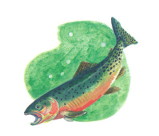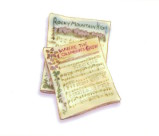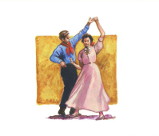State Symbols & Emblems
 Flag: Colorado's flag was designed by Andrew Carlisle Johnson. The blue stripes and the red "C" are of the same colors of blue and red that are found on the United States flag. The colors of the flag symbolize Colorado's geographical features: the gold symbolizes the state's abundant sunshine; the white represents snow-capped mountains; the blue symbolizes clear blue skies; and the red represents the color of much of the state's soil. The flag was adopted on June 5, 1911, by an act of the General Assembly. Flag: Colorado's flag was designed by Andrew Carlisle Johnson. The blue stripes and the red "C" are of the same colors of blue and red that are found on the United States flag. The colors of the flag symbolize Colorado's geographical features: the gold symbolizes the state's abundant sunshine; the white represents snow-capped mountains; the blue symbolizes clear blue skies; and the red represents the color of much of the state's soil. The flag was adopted on June 5, 1911, by an act of the General Assembly. |
||
|
Seal: The circular seal is an adaptation of the territorial seal. The seal depicts a heraldic shield bearing three snow-capped mountains on a red background and a miner's badge on a gold background. Above the shield is the eye of God within a triangle from which golden rays radiate. Below the eye is the Roman fasces, bearing upon a band of red, white, and blue the words "Union and Constitution." Below the shield is the motto, "Nil Sine Numine," Latin words meaning "nothing without the Deity." The words "State of Colorado" and "1876," the year Colorado came into statehood, surround the seal. The seal was adopted on March 15, 1877, by the first General Assembly. |
Colorado Day: August 1 of each year has been designated "Colorado Day" in celebration of the anniversary of Colorado's statehood. President Ulysses S. Grant signed the proclamation admitting Colorado to the Union on August 1, 1876. |
|
|
Animal: Rocky Mountain bighorn sheep (Ovis canadensis). Known for their agility and balance, the sheep are found only in the Rockies, usually above timberline in rugged mountainous areas. The male sheep can weigh up to 300 pounds, while the female is slightly smaller. The Rocky Mountain bighorn sheep was designated the state animal on May 1, 1961, by an act of the General Assembly.
|
Flower: White and lavender columbine (Aquilegia caerulea). In a statewide contest, the schoolchildren of Colorado chose the columbine as the state flower. State law makes it the duty of Colorado citizens to protect the state flower from needless destruction or waste, and prohibits uprooting the flower on public lands. The law also limits the gathering or picking of the flower on public lands to 25 stems, buds, or blossoms per day. The state flower was adopted on April 14, 1899, by an act of the General Assembly. |
Fish: Greenback cutthroat trout (Oncorhynchus clarki somias). This trout was at one time indigenous to many small creeks, streams, and rivers throughout the state, but it succumbed to pollution and to competition from other species of trout. Biologists feared that the species was extinct until, in the early 1990s, researchers discovered several small populations of the fish in remote streams in Rocky Mountain National Park. This colorful fish has now been reintroduced in numerous lakes and streams in the state and is reproducing successfully. The greenback cutthroat trout was designated the state fish on March 15, 1994, by an act of the General Assembly. |
|
Songs: "Where the Columbines Grow" and "Rocky Mountain High:' AJ. Flynn wrote the words and music to "Where the Columbines Grow:Traveling by horse and wagon in the San Luis Valley in 1896, Flynn was inspired by a beautiful mountain meadow covered with columbines. "Where the Columbines Grow" was designated the state song on May 8, 1915, by an act of the General Assembly. "Rocky Mountain High;' with lyrics by John Denver and music by Mike Taylor, was adopted by the General Assembly as an official co-state song on March 12, 2007. |
Fossil: Stegosaurus. The stegosaurus lived some 150 million years ago in the area now known as Colorado. It may have weighed up to 10 tons, though its brain weighed only 2.5 ounces. A stegosaurus skeleton discovered by a teacher and students from Canon City High School is on display at the Denver Museum of Nature and Science. The state fossil was designated on April 28, 1982, by executive order of Governor Richard Lamm. |
Tree: Colorado blue spruce (Picea pungens). First discovered on Pikes Peak in 1862 by the noted botanist Dr. C.C. Parry, the Colorado blue spruce is known for its symmetrical form and beautiful silver-blue color. Colorado schoolchildren voted on Arbor Day in 1892 to name the blue spruce as the state tree. It was not until March 7, 1939, that it was officially declared the state tree by an act of theGeneral Assembly. |
|
Grass: Blue grama grass (Bouteloua gracilis). Blue grama grass is native to Colorado and grows throughout the state on both sides of the continental divide. The grass's dense, hallow roots are important for erosion control. It was adopted on May 20, 1987, as the state grass by an act of the General Assembly. |
Folk Dance: Square dance. This dance traces its ancestry to the English country dance and French ballroom dance. A square dance is called, cued, or prompted to the dancers and includes squares, rounds, clogging, contra, line, the Virginia Reel, and heritage dances. It was designated the state folk dance on March 16, 1992, by an act of the General Assembly. |
Gemstone: Aquamarine. Aquamarine crystals are found in the 14,000-foot peaks of Mount Antero and the White Mountains. The crystals range in color from light blue to pale and deep aquamarine green. Aquamarine was declared the state gemstone on April30, 1971, by an act of the General Assembly. |
|
Insect: Colorado hairstreak butterfly (Hypaurotis crysalus). A native Colorado species, the butterfly is less than two inches wide and has purple wings with a wide dark border and orange spots. It is associated with scrub oak ecosystems on both the eastern and western slopes of the state. It was designated as state insect by an act of the General Assembly on April 17, 1996, through the efforts of Aurora school children. |
Bird: Lark bunting (Calamospiza melancorys stejneger). The lark bunting is a migratory bird that arrives in Colorado in April, inhabiting the plains regions and areas up to 8,000 feet in elevation. It flies south in September. The male bird is six to seven inches long and is black with snowy white patches. The slightly smaller female is grey brown. The state bird was designated on April 29, 1931, by an act of the General Assembly. |
Mineral: Rhodochrosite. The rhodochrosite crystals found in the Sweet Home Mine in Park County are large, deep red in color, and perfectly formed. They are some of the most prized specimens in the world. As a result of research and promotion by high school students from Bailey, rhodochrosite was designated as the state mineral on April18, 2002, by an act of the General Assembly. |
|
Tartan: The state tartan is comprised of a pattern and colors that symbolize Colorado's beauty and history. The blue symbolizes the state's clear blue skies, while the green represents the pine and spruce that are so abundant in Colorado's mountains. The contrasting colors of lavender and white are symbolic of the snow-capped granite mountain peaks. The gold and red in the pattern signify the wealth of mineral resources in the state and the red sandstone soil. The state tartan was adopted on March 3, 1997, by an act of the General Assembly. |
Rock: Yule marble.This white marble is comprised of almost pure calcite grains tightly joined to give it a luminous quality. Yule marble can be seen on the floors of the State Capitol and was also used in the Lincoln Memorial, t he Washington Monument, and the Tomb of the Unknown Soldier. Members of a Girl Scout Troop from Lakewood worked to gather the information that resulted in the designation of the state rock on March 9, 2004. |
Reptile: Western painted turtle (Chrysemys picta belIii). Schoolchildren from Denver suggested that this turtle, which is common around many lakes and ponds in Colorado, be designated the state reptile.The western painted turtle is the largest and most intricately patterned of the painted turtles. It has a smooth oliv e to brown carapace with light irregular lines, sometimes extending into a netlike pattern. It was declared the state reptile by an act of the General Assembly on March 18, 2008. |
|
Winter Sports: Skiing and snowboarding. For Coloradans, skiing has been a recreational sport since the 1880s, but it grew in popularity after World War II. Colorado's powder snow and high terrain attracts winter sports enthusiasts from around the United States and world. Skiing and snowboarding contribute in significant ways to the state's economy. Skiing and snowboarding were designated the state winter recreational sports on April 8, 2008, by an act of the General Assembly. |
||


















